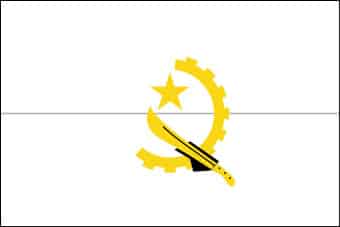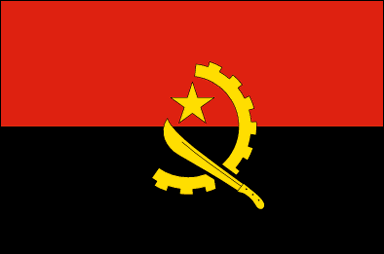
About Flag of Angola
The items in the insignia stand in for agricultural and industrial labourers. The star stands for global unity, the cogwheel represents labourers, the machete represents peasants and the nation’s armed resistance. The blood spilt by Angolans in their fight for national freedom and for their nation’s defence is symbolised by the colour red on the Angola Flag. The colour black represents the African continent. The yellow signifies Angola’s abundant mineral resources.
The Angolan flag was established during the Marxist era, and as a result, it resembles the communist flag.
Historical Background
The current design of the Angola flag was adopted on November 11, 1975, when the country gained independence from Portuguese colonial rule. The flag has undergone changes throughout Angola’s history, reflecting the political shifts and social transformations in the nation.
| Official Name: | The Republic of Angola |
| Proportion: | 2:3 |
| Adopted on: | November 11, 1975 |
| Location of the country: | Angola is bordered to the far northwest by the Republic of the Congo, to the north and northeast by the Democratic Republic of the Congo, to the southeast by Zambia, to the south by Namibia, and to the west by the Atlantic Ocean. |
| Capital City: | Luanda |
| Major Cities: | Bengo, Benguela, Namibe, Zaire |
| Area: | 481,354 square miles |
| Population: | 18,020,668 |
| Currency: | Kwanza |
| Official Language: | Portuguese |
| National Anthem: | Forward Angola |
| National symbol(s): | Palanca Negra Gigante (giant black sable antelope) |
| National colors: | red, black, yellow |
| National anthem: | |
| Name: | “Angola Avante” (Forward Angola) |
| Lyrics/music: | Manuel Rui Alves MONTEIRO/Rui Alberto Vieira Dias MINGAO |
Facts about the Angola flag |
| Country | Angola |
|---|---|
| Designed by | NA |
| Adopted | Nov 11, 1975 |
| Revision | NA |
| Design and Colors | The Angolan flag is divided into two halves – the top half is red and the bottom half is black. In the middle of the flag is a yellow emblem consisting of a partial cog wheel, a machete, and a star. |
| Size Ratio | 2:3 |
Design and Colors
The Angola flag features two horizontal bands of red and black, with a gold emblem in the center. The red band represents the bloodshed and sacrifices of the Angolan people during their struggle for independence. The black band symbolizes Africa and the continent’s rich cultural heritage. The emblem in the center consists of a machete and a gear wheel, representing agricultural workers and industrial workers, respectively, united in their pursuit of progress and development.
Symbolism of the Angola Flag
The colors and symbols on the Angola flag hold significant meaning. The red symbolizes the determination, courage, and sacrifice of the Angolan people in their fight for independence. The black represents Africa and the solidarity with other African nations. The machete and gear wheel in the emblem symbolize the importance of agriculture and industry in Angola’s development and the unity of the working class.
National Flag Day
November 11th is celebrated as National Flag Day in Angola. On this day, Angolans honor their flag and celebrate the country’s independence. Festivities, parades, cultural events, and flag-raising ceremonies are held to commemorate the significance of the Angola flag in the nation’s history and identity. More info
FAQs
Q1: When was the current design of the Angola flag adopted?
The current design of the Angola flag was adopted on November 11, 1975, when Angola gained independence from Portuguese colonial rule.
Q2: What is the significance of the emblem on the Angola flag?
The emblem on the flag consists of a machete and a gear wheel, representing agricultural workers and industrial workers, symbolizing progress, development, and the unity of the working class.

